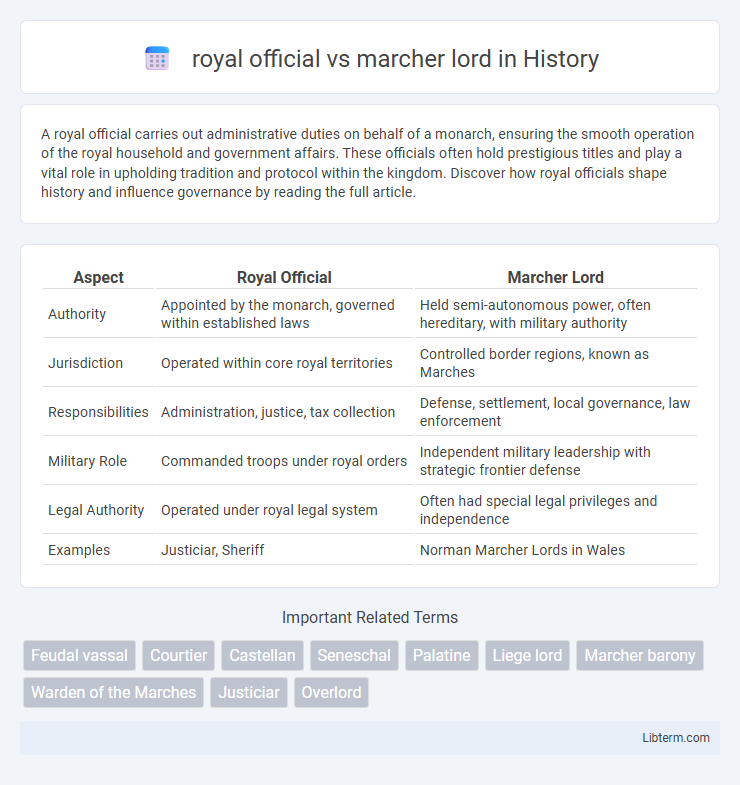A royal official carries out administrative duties on behalf of a monarch, ensuring the smooth operation of the royal household and government affairs. These officials often hold prestigious titles and play a vital role in upholding tradition and protocol within the kingdom. Discover how royal officials shape history and influence governance by reading the full article.
Table of Comparison
| Aspect | Royal Official | Marcher Lord |
|---|---|---|
| Authority | Appointed by the monarch, governed within established laws | Held semi-autonomous power, often hereditary, with military authority |
| Jurisdiction | Operated within core royal territories | Controlled border regions, known as Marches |
| Responsibilities | Administration, justice, tax collection | Defense, settlement, local governance, law enforcement |
| Military Role | Commanded troops under royal orders | Independent military leadership with strategic frontier defense |
| Legal Authority | Operated under royal legal system | Often had special legal privileges and independence |
| Examples | Justiciar, Sheriff | Norman Marcher Lords in Wales |
Introduction to Royal Officials and Marcher Lords
Royal officials were appointed representatives of the crown responsible for administering justice, collecting taxes, and maintaining order within the king's domain. Marcher lords held semi-autonomous territories along the border between England and Wales, wielding military power and judicial authority to defend frontier lands and manage local affairs. Both played crucial roles in medieval governance, with royal officials acting as agents of centralized control and marcher lords exercising localized power for frontier defense.
Historical Origins of Royal Officials
Royal officials originated during the medieval period as direct appointees of the crown, tasked with administering justice, collecting taxes, and enforcing royal authority within the king's domain. Their authority stemmed from the monarch's centralized power, distinguishing them from marcher lords, who held semi-autonomous control over border territories with inherited or granted lordship. This distinction highlights the royal officials' role in reinforcing centralized governance, contrasting with the marcher lords' localized military and administrative autonomy.
The Rise and Role of Marcher Lords
Marcher lords emerged during the Norman conquest as powerful feudal nobles granted extensive autonomy along the volatile Anglo-Welsh border to defend and expand the realm. Unlike royal officials directly appointed by the crown, marcher lords wielded quasi-sovereign powers, including building castles, administering justice, and raising armies independently. Their rise was pivotal in securing frontier regions, facilitating territorial expansion, and shaping medieval border governance.
Powers and Duties: Royal Official vs Marcher Lord
Royal officials enforced the crown's laws, administered justice, and managed royal estates with direct accountability to the monarchy. Marcher lords exercised near-sovereign authority in border regions, commanding military forces, administering local justice, and negotiating with neighboring powers to secure frontier defense. Their powers included autonomous rule and extended privileges, contrasting with royal officials' more centralized and regulated duties.
Land Ownership and Jurisdiction
Royal officials held land directly granted by the monarch, exercising jurisdiction that extended over entire counties or shires, allowing them to enforce royal laws and collect taxes. Marcher lords controlled border territories known as the Marches, possessing autonomous land rights with their own courts and military authority to defend and administer these frontier regions. The key distinction lies in the royal officials' allegiance to centralized crown authority, while marcher lords operated with semi-independent jurisdiction to manage and protect strategically sensitive lands.
Loyalty: Crown Authority vs Local Autonomy
Royal officials operated under direct crown authority, ensuring unwavering loyalty to the monarch and strict enforcement of centralized laws. Marcher lords exercised considerable local autonomy, balancing allegiance to the crown with independent governance to manage volatile border regions. The tension between royal control and marcher self-rule shaped medieval power dynamics and regional stability.
Legal Influence and Administration
Royal officials wield direct legal authority granted by the crown, overseeing courts and implementing royal justice in their jurisdictions. Marcher lords hold semi-autonomous legal powers, often operating independent courts with unique laws distinct from the crown's standard legal system. This autonomy allows marcher lords to administer justice and govern territories with significant local control, balancing royal influence with regional authority.
Military Responsibilities and Defense
Royal officials held command over larger, organized military forces and were responsible for the defense of strategic royal territories and key fortifications. Marcher lords had autonomous military authority in border regions, tasked with defending against external invasions and conducting localized raids, often operating with greater flexibility and independent armies. The military responsibilities of marcher lords included fortifying frontier lands and maintaining rapid response capabilities to secure the peripheries of the kingdom.
Conflicts and Cooperation: Case Studies
Conflicts between royal officials and marcher lords often arose over territorial control and legal jurisdiction, with marcher lords exercising quasi-sovereign powers in borderlands that sometimes clashed with royal authority. Case studies such as the Norman marcher lords in Wales illustrate how cooperation was necessary for defense against external threats, leading to negotiated settlements that balanced crown interests with local autonomy. These dynamics reveal a complex interplay where strategic alliances and intermittent disputes shaped medieval governance along contested frontiers.
Legacy and Impact on Medieval Governance
Royal officials centralized authority by enforcing the crown's laws and policies, shaping a unified governance structure across medieval kingdoms. Marcher lords exercised semi-autonomous power on frontier territories, balancing defense responsibilities with local lordship, influencing regional stability and border expansion. Their coexistence contributed to a complex feudal hierarchy, blending centralized control with localized authority that impacted medieval political evolution.
royal official Infographic

 libterm.com
libterm.com